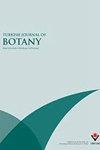利用海洋大型植物生物指数(EEI-c)分析土耳其沿海水域的生态质量状况
IF 1.5
4区 生物学
Q3 PLANT SCIENCES
引用次数: 1
摘要
:本研究包括土耳其海岸生态状况调查的第二个海底大型植物监测期的结果。生物指数生态评价指数(EEI-c)用于评估生态状况等级(ESC)和MA-LUSI(人为压力)。采样采用象限(20×20 cm)法,2017年至2019年间,从土耳其沿海水域的93个地点采集了样本。在土耳其海域总共发现了240个分类群。40个位点被归类为高ESC,24个位点被分类为好ESC,12个位点被划分为中等ESC,13个位点被分为差ESC,4个位点被评为坏ESC。压力指数MA-LUSI与EEIeqr值之间的关系也得到了检验,并发现负相关(R2=0.62)。本文章由计算机程序翻译,如有差异,请以英文原文为准。
Ecological quality status of the Turkish coastal waters by using a marine macrophytic biotic index (EEI-c)
: The present study includes the results of the second benthic macrophytes’ monitoring period of a survey of ecological status from the Turkish coasts. The biotic index Ecological Evaluation Index (EEI-c) was used to assess the ecological status classes (ESC) and MA-LUSI the anthropogenic pressures. Sampling was made by the quadrat (20 × 20 cm) method, and the samples were collected from 93 sites in Turkish coastal waters between 2017 and 2019. In total, 240 taxa were found in the Turkish marine waters. Forty sites were classified into High ESC, 24 sites into Good, 12 sites into Moderate, 13 sites into Poor, and 4 sites into Bad ESC. The relationship between the pressure index MA-LUSI and EEIeqr values was also tested, and a negative correlation (R 2 = 0.62) was found.
求助全文
通过发布文献求助,成功后即可免费获取论文全文。
去求助
来源期刊

Turkish Journal of Botany
PLANT SCIENCES-
CiteScore
2.90
自引率
5.60%
发文量
31
审稿时长
6-12 weeks
期刊介绍:
The Turkish Journal of Botany is published electronically 6 times a year by the Scientific and Technological Research Council of Turkey (TÜBİTAK) and accepts manuscripts (in English) covering all areas of plant biology (including genetics, evolution, systematics, structure, function, development, diversity, conservation biology, biogeography, paleobotany, ontogeny, functional morphology, ecology, reproductive biology, and pollination biology), all levels of organisation (molecular to ecosystem), and all plant groups and allied organisms (algae, fungi, and lichens). Authors are required to frame their research questions and discuss their results in terms of major questions in plant biology. In general, papers that are too narrowly focused, purely descriptive, or broad surveys, or that contain only preliminary data or natural history, will not be considered (*).
The following types of article will be considered:
1. Research articles: Original research in various fields of botany will be evaluated as research articles.
2. Research notes: These include articles such as preliminary notes on a study or manuscripts on the morphological, anatomical, cytological, physiological, biochemical, and other properties of plant, algae, lichen and fungi species.
3. Reviews: Reviews of recent developments, improvements, discoveries, and ideas in various fields of botany.
4. Letters to the editor: These include opinions, comments relating to the publishing policy of the Turkish Journal of Botany, news, and suggestions. Letters should not exceed one journal page.
(*) 1. Raw floristic lists (of algae, lichens, fungi, or plants), species descriptions, chorological studies, and plant sociology studies without any additional independent approaches.
2. Comparative morphology and anatomy studies (that do not cover a family, tribe, subtribe, genus, subgenus, section, subsection, or species complexes with taxonomical problems) without one or more independent additional approaches such as phylogenetical, micromorphological, chromosomal and anatomical analyses.
3. Revisions of family, tribe, genus, subgenus, section, subsection, or species complexes without any original outputs such as taxonomical status changes, IUCN categories, and phenological and ecological analyses.
4. New taxa of all plants without any additional independent approaches such as phylogenetical, ecological, chromosomal, chorological and correlational analyses in addition to a detailed macro- and micro-morphological descriptions with quality field and microscopic illustrations of taxonomically important structures and identification key in the taxonomic group.
New records of all plants without any additional independent approaches such as phylogenetical, ecological, chromosomal, chorological and correlational analyses in addition to a detailed macro- and micro-morphological descriptions with quality field and microscopic illustrations of taxonomically important structures and identification key in the taxonomic group may be accepted for peer review if they contain 3 or more new records or taxonomical status update, such as lectotypification, new combinations, transfers, revivals and synonyms.
5. New taxa of algae, lichens, and fungi without any additional independent approaches such as phylogenetical, ecological, chromosomal, chorological and correlational analyses in addition to a detailed macro- and micro-morphological descriptions with quality field and microscopic illustrations of taxonomically important structures and identification key in the taxonomic group.
New records of algae, lichens, and fungi without any additional independent approaches such as phylogenetical, ecological, chromosomal, chorological and correlational analyses in addition to a detailed macro- and micro-morphological descriptions with quality field and microscopic illustrations of taxonomically important structures and identification key in the taxonomic group may be accepted for peer review if they contain 5 or more new records or taxonomical status update, such as lectotypification, new combinations, transfers, revivals and synonyms.
 求助内容:
求助内容: 应助结果提醒方式:
应助结果提醒方式:


